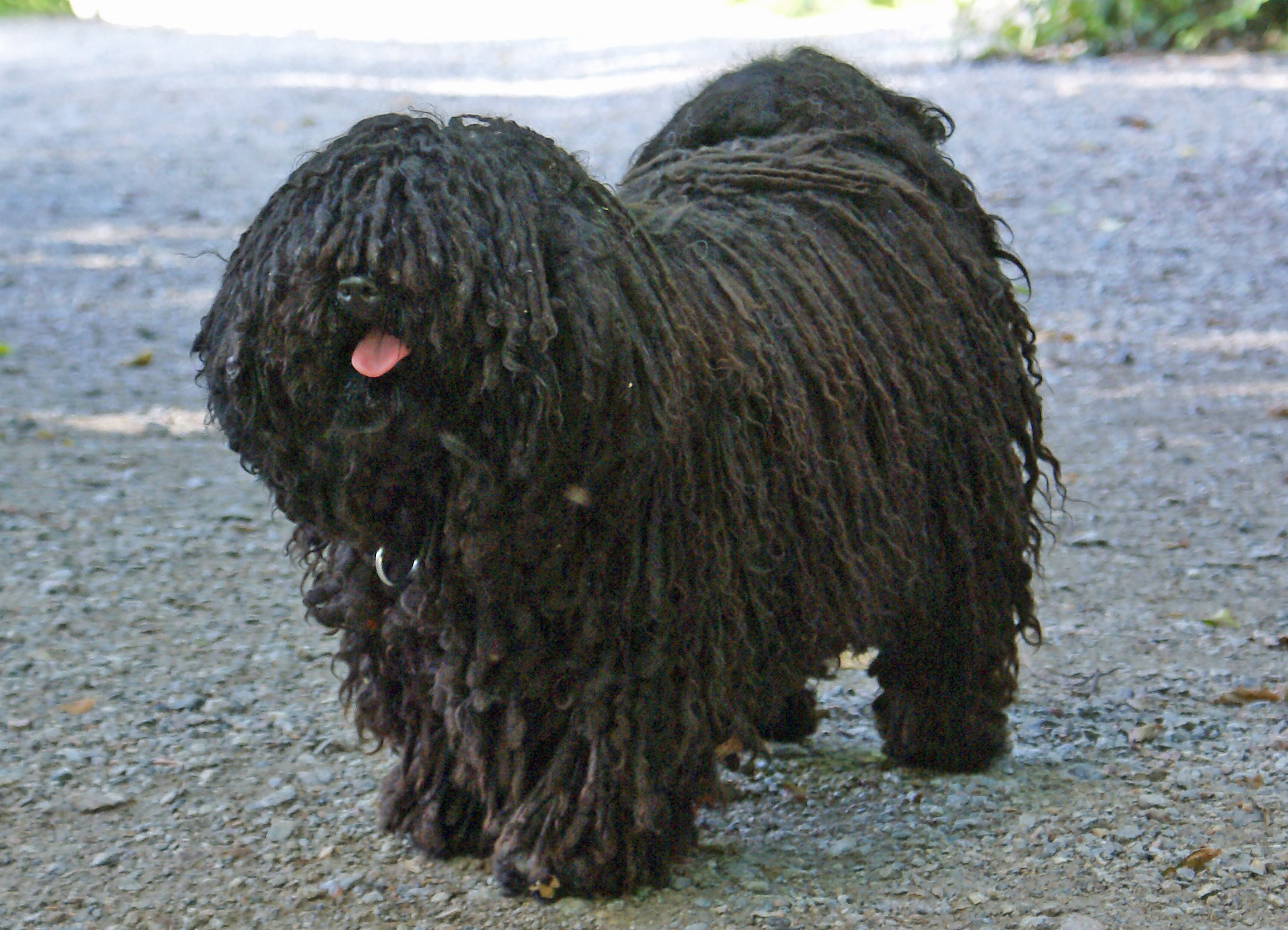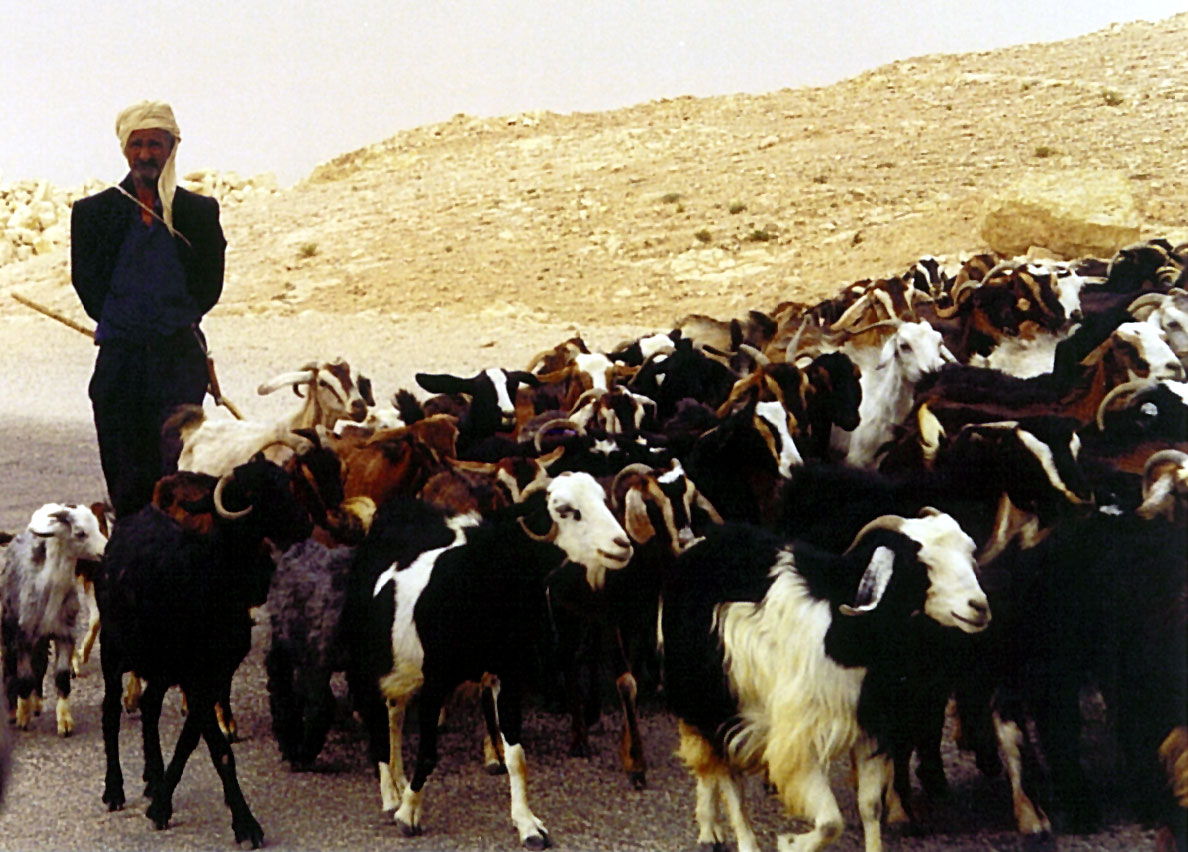|
Puli Dog
The Puli is a small-medium breed of Hungarian herding and livestock guarding dog known for its long, corded coat. The tight curls of the coat appear similar to dreadlocks. A similar-looking, but much larger breed – also Hungarian – is the Komondor. Plural form of Puli is ''Pulik'' in Hungarian. Description Appearance The Puli is a solid-colored dog that is usually black. Other less common coat colors are white, gray, or cream (off-white or ''fakó'' in Hungarian). A variety of the cream-coated dogs have black masks. The white Pulis are not albino, nor do they have blue eyes. They commonly have dark pigment, black pads, black noses and black pigment inside the mouth. The white gene is recessive to the pure black gene. The breed standard for females is about 16.5 inches (42 cm) at the withers and 17 inches for males. Females weigh 23-25 pounds and males slightly more. The coat of some Puli dogs can be different with either thinner or thicker cords whi ... [...More Info...] [...Related Items...] OR: [Wikipedia] [Google] [Baidu] |
Hungary
Hungary ( hu, Magyarország ) is a landlocked country in Central Europe. Spanning of the Carpathian Basin, it is bordered by Slovakia to the north, Ukraine to the northeast, Romania to the east and southeast, Serbia to the south, Croatia and Slovenia to the southwest, and Austria to the west. Hungary has a population of nearly 9 million, mostly ethnic Hungarians and a significant Romani minority. Hungarian, the official language, is the world's most widely spoken Uralic language and among the few non-Indo-European languages widely spoken in Europe. Budapest is the country's capital and largest city; other major urban areas include Debrecen, Szeged, Miskolc, Pécs, and Győr. The territory of present-day Hungary has for centuries been a crossroads for various peoples, including Celts, Romans, Germanic tribes, Huns, West Slavs and the Avars. The foundation of the Hungarian state was established in the late 9th century AD with the conquest of the Carpathian Basin by Hungar ... [...More Info...] [...Related Items...] OR: [Wikipedia] [Google] [Baidu] |
Herding Dog
A herding dog, also known as a stock dog, shepherd dog, sheep dog or working dog, is a Dog type, type of dog that either has been trained in herding or belongs to dog breed, breeds that are developed for herding. Herding behavior All herding behavior is modified predatory behavior. Through selective breeding, humans have been able to minimize the dog's natural inclination to treat cattle and sheep as prey while simultaneously maintaining the dog's hunting skills, thereby creating an effective herding dog. Dogs can work other animals in a variety of ways. Some breeds, such as the Australian Cattle Dog, typically nip at the heels of animals (for this reason they are called ''heelers'') and the Cardigan Welsh Corgi, Cardigan and Pembroke Welsh Corgis were historically used in a similar fashion in the cattle droves that moved cattle from Wales to the Smithfield Meat Market in London but are rarely used for herding today. Other breeds, notably the Border Collie, get in front o ... [...More Info...] [...Related Items...] OR: [Wikipedia] [Google] [Baidu] |
Siberia
Siberia ( ; rus, Сибирь, r=Sibir', p=sʲɪˈbʲirʲ, a=Ru-Сибирь.ogg) is an extensive geographical region, constituting all of North Asia, from the Ural Mountains in the west to the Pacific Ocean in the east. It has been a part of Russia since the latter half of the 16th century, after the Russians conquered lands east of the Ural Mountains. Siberia is vast and sparsely populated, covering an area of over , but home to merely one-fifth of Russia's population. Novosibirsk, Krasnoyarsk and Omsk are the largest cities in the region. Because Siberia is a geographic and historic region and not a political entity, there is no single precise definition of its territorial borders. Traditionally, Siberia extends eastwards from the Ural Mountains to the Pacific Ocean, and includes most of the drainage basin of the Arctic Ocean. The river Yenisey divides Siberia into two parts, Western and Eastern. Siberia stretches southwards from the Arctic Ocean to the hills of north-ce ... [...More Info...] [...Related Items...] OR: [Wikipedia] [Google] [Baidu] |
Migration Of The Magyars
Hungarian prehistory ( hu, magyar őstörténet) spans the period of history of the Hungarian people, or Magyars, which started with the separation of the Hungarian language from other Finno-Ugric or Ugric languages around , and ended with the Hungarian conquest of the Carpathian Basin around . Based on the earliest records of the Magyars in Byzantine, Western European, and Hungarian chronicles, scholars considered them for centuries to have been the descendants of the ancient Scythians and Huns. This historiographical tradition disappeared from mainstream history after the realization of similarities between the Hungarian language and the Uralic languages in the late . Thereafter, linguistics became the principal source of the study of the Hungarians' ethnogenesis. In addition, chronicles written between the , the results of archaeological research and folklore analogies provide information on the Magyars' early history. Study of pollen in fossils based on cognate words for ... [...More Info...] [...Related Items...] OR: [Wikipedia] [Google] [Baidu] |
Magyars
Hungarians, also known as Magyars ( ; hu, magyarok ), are a nation and ethnic group native to Hungary () and historical Hungarian lands who share a common culture, history, ancestry, and language. The Hungarian language belongs to the Uralic language family. There are an estimated 15 million ethnic Hungarians and their descendants worldwide, of whom 9.6 million live in today's Hungary. About 2–3 million Hungarians live in areas that were part of the Kingdom of Hungary before the Treaty of Trianon in 1920 and are now parts of Hungary's seven neighbouring countries, Slovakia, Ukraine, Romania, Serbia, Croatia, Slovenia, and Austria. Significant groups of people with Hungarian ancestry live in various other parts of the world, most of them in the United States, Canada, Germany, France, the United Kingdom, Chile, Brazil, Australia, and Argentina. Hungarians can be divided into several subgroups according to local linguistic and cultural characteristics; subgroups with distinct ... [...More Info...] [...Related Items...] OR: [Wikipedia] [Google] [Baidu] |
Herding
Herding is the act of bringing individual animals together into a group (herd), maintaining the group, and moving the group from place to place—or any combination of those. Herding can refer either to the process of animals forming herds in the wild, or to human intervention forming herds for some purpose. While the layperson uses the term "herding" to describe this human intervention, most individuals involved in the process term it mustering, "working stock", or droving. Some animals instinctively gather together as a herd. A group of animals fleeing a predator will demonstrate herd behavior for protection; while some predators, such as wolves and dogs have instinctive herding abilities derived from primitive hunting instincts. Instincts in herding dogs and trainability can be measured at noncompetitive herding tests. Dogs exhibiting basic herding instincts can be trained to aid in herding and to compete in herding and stock dog trials. Sperm whales have also been observe ... [...More Info...] [...Related Items...] OR: [Wikipedia] [Google] [Baidu] |
Herding
Herding is the act of bringing individual animals together into a group (herd), maintaining the group, and moving the group from place to place—or any combination of those. Herding can refer either to the process of animals forming herds in the wild, or to human intervention forming herds for some purpose. While the layperson uses the term "herding" to describe this human intervention, most individuals involved in the process term it mustering, "working stock", or droving. Some animals instinctively gather together as a herd. A group of animals fleeing a predator will demonstrate herd behavior for protection; while some predators, such as wolves and dogs have instinctive herding abilities derived from primitive hunting instincts. Instincts in herding dogs and trainability can be measured at noncompetitive herding tests. Dogs exhibiting basic herding instincts can be trained to aid in herding and to compete in herding and stock dog trials. Sperm whales have also been observe ... [...More Info...] [...Related Items...] OR: [Wikipedia] [Google] [Baidu] |
Tracking (dog)
Tracking refers to a dog's ability to detect, recognize and follow a specific scent. Possessing heightened olfactory abilities, dogs, especially scent hounds, are able to detect, track and locate the source of certain odours.Hepper, P. G., & Wells, D. L. (2005). How many footsteps do dogs need to determine the direction of an odour trail?. Chemical Senses, 30(4), 291–298. A deeper understanding of the physiological mechanisms and the phases involved in canine scent tracking has allowed humans to utilize this animal behaviour in a variety of professions. Through domestication and the human application of dog behaviour, different methods and influential factors on tracking ability have been discovered. While tracking was once considered a predatory technique of dogs in the wild, it has now become widely used by humans. Physiological mechanisms According to zoosemiotics animal communication involves an exchange of information between a sender and a receiver through a transfer of ... [...More Info...] [...Related Items...] OR: [Wikipedia] [Google] [Baidu] |
Flyball
Flyball is a dog sport in which teams of dogs race against each other from the start to the finish line, over a line of hurdles, to a box that releases a tennis ball to be caught when the dog presses the spring-loaded pad, then back to their handlers while carrying the ball. Flyball is run in teams of four dogs, as a relay. The course consists of four hurdles placed 10 feet (3 m) apart from each other, with the starting line six feet (1.8 m) from the first hurdle, and the flyball box 15 feet (4.5 m) after the last one, making for a 51-foot (15.5 m) length. The hurdle height is determined by the ulna's length or the smallest dog's shoulder height on the team (depending on the association). For example, under current North American Flyball Association (NAFA) rules, this should be 5 inches (12.7 cm) below the withers height of the smallest dog, to a height of no less than 7 inches (17.8 cm) and no greater than 14 inches (35.6 cm). United Kingdom Flyba ... [...More Info...] [...Related Items...] OR: [Wikipedia] [Google] [Baidu] |
Dog Showmanship
Dog showmanship is a set of skills and etiquette used by handlers of dogs in a dog competition. Dog showmanship is not a competition in itself but a qualification of the handler to present a dog to its best advantage. Skills are technical as well as artistic. A handler must groom and display the dog for a judge in specific ways but a true showman can accentuate the best features of the dog and even mask any faults. Many professional handlers train and condition the dogs they accept into their program as they see fit. This means that dogs owned by others are away from home with their handlers for months at a time. Professional showmen may handle dogs as a sole source of income. Most often referring to handling for dog conformation competition, showmanship can also refer to hunting dog competition, racing dogs, and tracking dogs. It also refers to the sportsmanship of competitors; able to lose with grace, win with humility and unflappable in the face of unforeseen circumstances. A ... [...More Info...] [...Related Items...] OR: [Wikipedia] [Google] [Baidu] |





